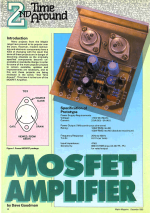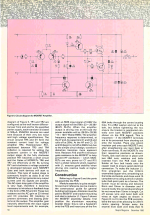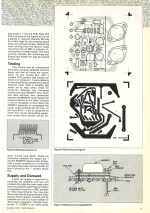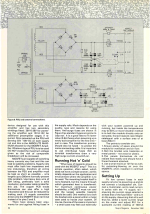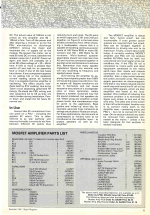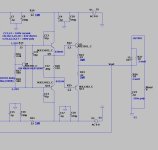Good morning everyone: many years ago I already created some low-power transistor amplifiers. Three years ago I finished a 100W Mosfet power amplifier (successfully). As specified in the title I would like to start building a hi-fi transistor power amplifier. I took a look at a couple of schemes here on Diyaudio, (example Symef 2), but I honestly don't know how to orient myself: there are certainly many other solutions: there is some kind person who can help me in the choice, considering following :
(in addition to the classic hi fi performances):
thanks for your attention.
Regards
Ros
(in addition to the classic hi fi performances):
- it should have a power range from 50 to approximately 100W;
- I have excellent experience in electronic CAD, PCB, assembly, GND care, design, and laboratory instrumentation.
thanks for your attention.
Regards
Ros
thank you for taking the time to answer me hbtaudio; It seems like a good start to me, regards Ros . I'll take some time to take a look as soon as I can...
Apex AX6 https://www.diyaudio.com/forums/solid-state/236256-retro-amp-50w-single-supply-42.html has a single supply so if a wire pops loose, the speaker capacitor keeps the DC from blowing up your speaker. I built mine point to point on NEMA C 1/16" board. I got 75 w/ch for 5 seconds out of it in a dynaco ST120 chassis. I used NTE60 output transistors, TO3 mounted remotely from the driver board. I believe those were MJ15003 in a white NTE box. I put more heat sink fins on than ST120 had, and installed fans, since ST120 blew up so many output transistor due to heat. I replaced the squirrely PC15 regulator with a regulated 69 v power supply, down from the 73 v open circuit of the ST120. 5 darlington TIP142 paralleled driven by a 72 v zener stack.
75 W is enough to drive me into earplugs on 98 db 1w1m SP2 speakers. The track was Rhianna Shut Up & Drive the bass climax. Measurement was on SP2 speaker and a Simpson 266XLPM Voltmeter 100 vac scale.
75 W is enough to drive me into earplugs on 98 db 1w1m SP2 speakers. The track was Rhianna Shut Up & Drive the bass climax. Measurement was on SP2 speaker and a Simpson 266XLPM Voltmeter 100 vac scale.
Last edited:
Do you favor simple or complex designs?
If you stick with a familiar 3-stage Class AB amplifiers with a LTP IPS and single-ended VAS, these two are at opposite ends of the spectrum:
Simple: Rod Elliott's P3A
Complex: Douglas Self's Load Invariant Blameless
PCB and build guidance are available for both. They both have output power in the range you specified and are all BJT. Both are well regarded designs that have been in use for decades. Though the Blameless is more complex, it's still an approachable design.
Note that both these use a CFP output stage, which is a bit of a hot topic on this forum. There are far more designs using EF2 or EF3 output stages. I'm not advocating CFP here, but simply using these two as examples of well known designs that meet your requirements but vary quite a bit in how they approach it.
These are both successful established designs, but they both have their critics. The Blameless follows the premises that if it measures well, it should sound good - not everyone agrees with this. The P3A claims the added complexity to measure better is not necessary. Many claim it sounds very good despite not measuring as well.
Note: The P3A is particularly sensitive to PCB layout. If you pursue this design, I'd encourage the use of Rod Elliott's PCBs unless you are experienced with CFP designs.
If you tell us which way you lean, I'm sure others can recommend additional designs.
If you stick with a familiar 3-stage Class AB amplifiers with a LTP IPS and single-ended VAS, these two are at opposite ends of the spectrum:
Simple: Rod Elliott's P3A
Complex: Douglas Self's Load Invariant Blameless
PCB and build guidance are available for both. They both have output power in the range you specified and are all BJT. Both are well regarded designs that have been in use for decades. Though the Blameless is more complex, it's still an approachable design.
Note that both these use a CFP output stage, which is a bit of a hot topic on this forum. There are far more designs using EF2 or EF3 output stages. I'm not advocating CFP here, but simply using these two as examples of well known designs that meet your requirements but vary quite a bit in how they approach it.
These are both successful established designs, but they both have their critics. The Blameless follows the premises that if it measures well, it should sound good - not everyone agrees with this. The P3A claims the added complexity to measure better is not necessary. Many claim it sounds very good despite not measuring as well.
Note: The P3A is particularly sensitive to PCB layout. If you pursue this design, I'd encourage the use of Rod Elliott's PCBs unless you are experienced with CFP designs.
If you tell us which way you lean, I'm sure others can recommend additional designs.
The only BJT amp I've heard that I liked was the Yorkville AP1200... Schematics are online. Just scale down the output stage unless 8 MJ15022 and 8 MJ15023 per channel is reasonable. 300W RMS into 8R.
Here's the output board -

Here's the output board -
first of all I thank everyone for the precious suggestions: indiana, brian, jdx, kodab. In reality I deal with completely different electronics, and for a few years I have been entering the audio field which has always fascinated me. I'm not an expert in audio circuits, but I'm trying to fill this gap by reading and studying. I have already created a MOS power amp (not of my own design) with notable performance that sounds good (for me). I designed and created a very high-performance hi-fi op amp preamplifier, complete with all stages, inputs, tone control, and output buffer; this one also has rather strong (measured) characteristics and I really like how it sounds. Now as mentioned, I would like to create a high-performance transistor amplifier. My problem is the same as everyone else's: time. Between work, family and personal commitments I also have to 'fit' my hobbies. In any case, thanks to everyone and I always remain open to suggestions. P.S. expect me to bother you again for clarifications on the various types of circuits. A good day everyone.
Ros
Ros
Simple but powerful enough amplifier for beginners and not only
The final stage can be replaced with a bipolar darlington NPN PNP stage
The final stage can be replaced with a bipolar darlington NPN PNP stage
Attachments
Thanks for your reply guys:
I would have found two candidates at the moment: hellraiser and bc-1.
From what I have read:
-hellraiser (with smt parts) very interesting, but it still needs to be optimized in some small parts / values ;
-BC 1 the same: very interesting too, but it seems project is not total free: you have to contact a user who provides document with all the update details - including schematic and bom - only after purchasing the PCBs from him.
Since I leafed through the pages rather quickly, I also consider the probability of having read it wrong,
therefore as soon as I have some time available I read all the pages of the respective threads better (which are quite a few).
In the meantime I'll take a look around the forum to look for other possible good solutions.
I am always open to new suggestions from anyone.
Thanks to all.
hello guys nice day
Ros
I would have found two candidates at the moment: hellraiser and bc-1.
From what I have read:
-hellraiser (with smt parts) very interesting, but it still needs to be optimized in some small parts / values ;
-BC 1 the same: very interesting too, but it seems project is not total free: you have to contact a user who provides document with all the update details - including schematic and bom - only after purchasing the PCBs from him.
Since I leafed through the pages rather quickly, I also consider the probability of having read it wrong,
therefore as soon as I have some time available I read all the pages of the respective threads better (which are quite a few).
In the meantime I'll take a look around the forum to look for other possible good solutions.
I am always open to new suggestions from anyone.
Thanks to all.
hello guys nice day
Ros
You would expect to pay for the boards wouldn't you? The information supplied includes the latest revisions. I have done this and the result is an excellent amplifier.
Mosfets are 10x faster. I can't get BJT output stages stable without a comp cap limiting the frequency response to 500khz.
Sounds like alot but this is open loop.
Fets 10mhz
Sounds like alot but this is open loop.
Fets 10mhz
@stocktrader200
good morning, strocktrader thanks for your suggestion: actually the last 50+50Wrms amplifier I finished was a mosfet one (IRF240/9140) and it sounds divine. I hope put some pictures soon here of my build. I wanted to start looking at another amplifier but this time a transistor one out of mere personal auditory curiosity 🙂
good morning, strocktrader thanks for your suggestion: actually the last 50+50Wrms amplifier I finished was a mosfet one (IRF240/9140) and it sounds divine. I hope put some pictures soon here of my build. I wanted to start looking at another amplifier but this time a transistor one out of mere personal auditory curiosity 🙂
@Thripster
thripster good morning, thanks for the reply. In reality, (if you are referring to the BC-1) looking at the initial schematic, I also consider it a good product to definitely take into consideration. Having said that, I honestly have no interest in going into the merits of what a user decides to do with his projects: among other things, I don't even know the price of the PCB. Rather, I really enjoy using CAD to make the PCB.
Un saluto to everyone .
Ros
thripster good morning, thanks for the reply. In reality, (if you are referring to the BC-1) looking at the initial schematic, I also consider it a good product to definitely take into consideration. Having said that, I honestly have no interest in going into the merits of what a user decides to do with his projects: among other things, I don't even know the price of the PCB. Rather, I really enjoy using CAD to make the PCB.
Un saluto to everyone .
Ros
- Home
- Amplifiers
- Solid State
- Build a Transistor power amplifier (no Mos)
